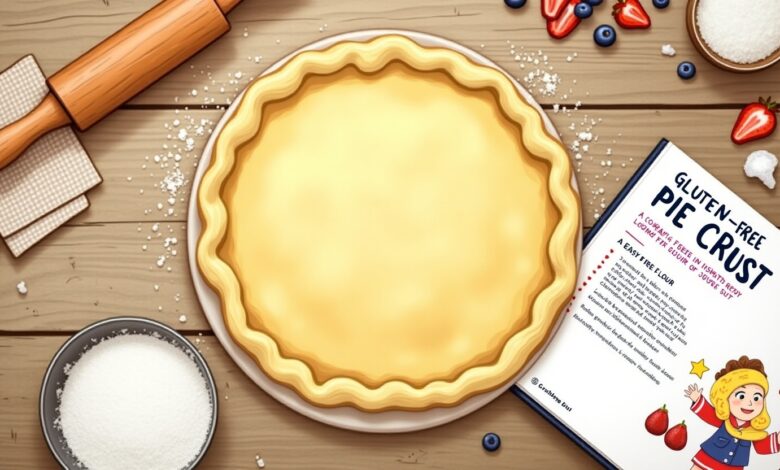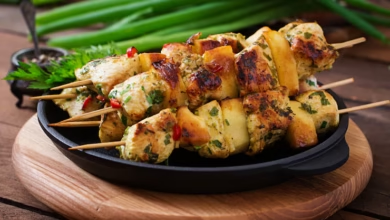Gluten Free Pie Crust Made Easy: A Simple Guide for Yummy Pies

Gluten Free Pie Crust can be soft, tasty, and fun to make. If you cannot eat gluten, don’t worry—this crust is perfect for you. You can still enjoy sweet or savory pies with a crispy, golden crust that doesn’t fall apart.
Many people think gluten free pie crust is hard to make, but it’s not. You just need the right mix of flour, a bit of patience, and simple steps. In this blog, I will show you how to make a crust that’s just as good (or better!) than the regular one. It’s great for holiday pies, fruit pies, or even quiches!
What Is a Gluten Free Pie Crust and Why It’s So Special
A gluten free pie crust is made without any wheat flour. People who have gluten allergies or celiac disease cannot eat gluten. This pie crust is made using other flours like almond, rice, or oat flour. It lets everyone enjoy pies without getting sick or feeling bad.
Many people think they have to give up pies if they eat gluten free. That’s not true. You can still enjoy your favorite pies with a tasty crust that is soft and flaky. Gluten free pie crust tastes a little different but can be just as yummy. It is great for both sweet and savory pies.
This crust is special because it gives people a safe way to enjoy food they love. You don’t have to worry about gluten hurting your stomach. Also, it is perfect for parties where guests may have food allergies. A pie with a gluten free crust shows care and kindness to others.
Easy Ingredients You Need for a Perfect Gluten Free Pie Crust
To make a good gluten free pie crust, you only need a few simple things. Most of these items are easy to find at the store. You just need the right mix to make the crust soft and flaky. It’s okay if you don’t get it perfect the first time—practice makes it better!
One of the most important ingredients is gluten free flour. You can use a ready-made gluten free flour blend, or you can mix your own with almond flour, rice flour, and a little cornstarch. These flours help the crust hold together without using wheat.
You also need cold butter or shortening. This helps make the crust soft and crumbly in the best way. Cold butter makes the crust flaky and gives it a nice golden color. Some people also use coconut oil if they don’t want to use dairy.
Don’t forget a pinch of salt and a little bit of sugar if you want a sweet crust. You’ll also need cold water to mix the dough. The water helps bring the dough together. Just be sure not to use too much. Now you’re ready to roll it out and make a great pie!
Step-by-Step: How to Make a Gluten Free Pie Crust at Home
Making a gluten free pie crust at home is easier than it sounds. You don’t need any fancy tools or machines. Just a bowl, a spoon, and your hands are enough. Follow these simple steps to get a soft and tasty crust every time.
First, mix your dry ingredients in a bowl. Add your gluten free flour blend, a little salt, and sugar if needed. Stir them together well so the mix is even. This helps the crust bake nicely and taste better.
Next, add cold butter or shortening. Cut it into small pieces and mix it into the flour using your fingers or a pastry cutter. The dough should look crumbly like wet sand. This step is important for getting a flaky crust.
Then, slowly add cold water, just a spoon at a time. Mix gently until the dough comes together. Don’t knead it too much or it may break apart later. Form it into a ball, wrap it in plastic, and chill it in the fridge for 30 minutes. After that, you can roll it out and use it in your favorite pie.
Common Mistakes to Avoid When Making Gluten Free Pie Crust
Sometimes the gluten free pie crust doesn’t turn out right, and that’s okay. It happens to everyone. But if you know the common mistakes, you can stop them before they happen. This will help your crust be soft, flaky, and yummy every time.
One big mistake is using too much water. This can make the dough sticky and hard to roll. Add just a little water at a time, and stop when the dough comes together. It’s better to be a bit dry than too wet.
Another mistake is not chilling the dough. Cold dough rolls out better and bakes into a flakier crust. Always let your dough rest in the fridge for at least 30 minutes before using it. This makes a big difference.
Many people also try to roll the dough too thin or too thick. A thin crust might break, and a thick crust might stay soft and doughy. Try to roll it to about 1/4 inch for the best results. With a little practice, your crust will turn out just right every time.
How to Keep Your Gluten Free Pie Crust from Crumbling
It can be hard when your gluten free pie crust keeps falling apart. But don’t worry—this is a common problem, and you can fix it. A few easy changes can make your crust stay strong and hold its shape better.
First, try using a binder in your dough. Things like xanthan gum or psyllium husk help the dough stay together. These are safe to eat and work like glue in the flour. You only need a little, but it really helps the crust not crumble.
Also, make sure your butter is cold and cut in well. This helps the fat stick to the flour and hold it all in one piece. When you mix your dough, don’t press too hard. Be gentle and stop mixing when the dough holds together.
When you roll out the dough, do it between two sheets of parchment paper. This keeps it from breaking. If a piece breaks off, you can press it back on. Gluten free crust is more delicate, but with care, you can make it just right. Practice helps a lot, so don’t give up!
Can You Freeze Gluten Free Pie Crust? Here’s the Answer
Yes, you can freeze gluten free pie crust! This is great news if you want to save time. You can make the dough ahead and freeze it for later. This helps you get ready for holidays or busy days when you want a pie fast.
To freeze the dough, first make your crust and shape it into a flat disc. Wrap it tightly in plastic wrap and then put it in a freezer bag. It will stay good for up to 2 months. Just write the date on the bag so you don’t forget.
When you’re ready to use it, take it out and let it thaw in the fridge overnight. Don’t try to warm it fast, or it might get sticky. Once it’s soft, you can roll it out and use it like fresh dough.
You can also freeze a baked crust or even a full pie with the crust already on. Just wrap it well to keep it fresh. Freezing gluten free pie crust is a smart way to save time and reduce stress.
Best Flours to Use for a Tasty Gluten Free Pie Crust
Not all flours work well in a gluten free pie crust. Some are too dry, and others don’t hold together. But the good news is, there are many great flour options to choose from that make a soft and tasty crust.
Best Flours for Crust:
- Almond Flour – adds a nutty flavor and soft texture
- Rice Flour – light and perfect for flaky crusts
- Tapioca Flour – helps with stretch and binding
- Sorghum Flour – gives a rich flavor like wheat
- Oat Flour – mild taste and easy to work with
You can mix two or three flours to get the best result. Most store-bought gluten free flour mixes already have a good blend inside. You can try a few and see which one you like best. Everyone has a favorite!
Try to avoid coconut flour by itself—it’s very dry and hard to work with. A little is okay in a mix. The key is balance. A soft and strong gluten free pie crust needs the right mix of flavor and texture.
Sweet vs. Savory: Making Gluten Free Pie Crust for Any Pie
Some pies are sweet, and some are savory. The great thing is, you can use gluten free pie crust for both! You just need to change a few things in the crust to match the kind of pie you want to make.
For Sweet Pies:
- Add 1–2 tablespoons of sugar to the dough
- Use a bit of vanilla or cinnamon for more flavor
- Perfect for fruit pies, chocolate pies, or custards
For Savory Pies:
- Skip the sugar
- Add herbs like thyme or rosemary to the dough
- Works well for quiches, pot pies, or veggie pies
You can use the same crust recipe and just tweak the flavor. This makes baking fun and easy. You don’t need a different recipe for every pie. One gluten free pie crust can do it all with a little change.
Tips from Bakers: How to Get a Flaky Gluten Free Pie Crust
Many bakers have smart tips for making the perfect gluten free pie crust. These small tricks help make your crust flaky, soft, and yummy. Let’s learn from the experts!
Best Baking Tips:
- Use Cold Butter – always keep butter in the fridge until ready
- Chill the Dough – resting the dough helps it stay firm and easy to roll
- Don’t Overmix – mix just enough to hold the dough together
- Roll Between Paper – keeps the dough from sticking or breaking
- Use Pie Weights – when blind baking, this stops crust from puffing up
These tips are simple but very helpful. Even beginner bakers can follow them. The more pies you make, the better your crust will get. Keep trying, and you’ll soon bake like a pro!
Conclusion
Making a gluten free pie crust is not hard when you know the right steps. You just need the right flour, cold butter, and a little time. With some love and practice, your crust will be soft, flaky, and super tasty. It’s a great way to enjoy pies if you can’t eat gluten.
Don’t worry if it doesn’t come out perfect the first time. Try again, and it will get better. Baking is fun, and every pie is special. Now you can make sweet or savory pies that everyone can enjoy, even friends who eat gluten free!
FAQs
Q: What is a gluten free pie crust made of?
A: It’s made with gluten free flours like almond, rice, or oat flour, plus butter and cold water.
Q: Can I freeze gluten free pie crust?
A: Yes! You can freeze the dough or a baked crust for up to 2 months. Just wrap it well.
Q: Why does my gluten free pie crust fall apart?
A: It may need a binder like xanthan gum, or it might be too dry. Try adding less water and chilling the dough.
Q: What’s the best flour for gluten free pie crust?
A: Almond flour and rice flour are great. You can also use a gluten free flour blend from the store.
Q: Can I use this crust for both sweet and savory pies?
A: Yes! Just add sugar for sweet pies or herbs for savory ones. One crust works for both.



